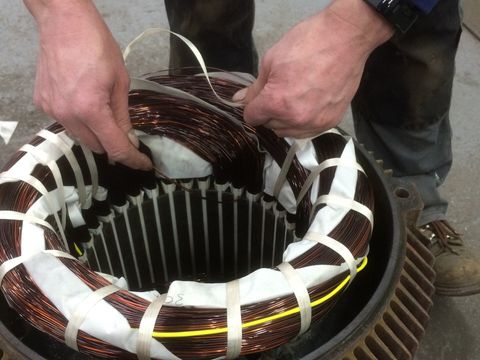75kW Compressor Motor Rewind and Repairs
This is a 3ph electric motor from a screw compressor from a factory located in Hull. It was brought in to us for repair following reports that the circuit breaker that supplies the compressor was tripping out. The factory maintenance electrician did some in depth tests which indicated that the motor windings had failed.
We offered to attend site to do further tests and to give a second opinion but the electrician was confident of his findings so our attendance on site was not required.
Firstly the motor is dismantled for inspection. In this case the drive end bearing had run dry and overheated, metal fragments had entered the windings and caused significant damage.
The next step is to start the motor rewinding process. Details are taken from the original motor windings and recorded. Then the lead end of the windings is cut off using specially made tools, this will allow for the windings to be fully removed after the stator has been in our burnout oven. The burnout oven is a high temperature oven which heats the stator to a pre-set temperature for a pre-set time. This slowly destroys everything organic and leaves just the metal components.
It is important not to apply too much heat to remove the old coils. Many companies use gas blow torches which can cause a lot of damage. Excessive heat will change the metallic properties of the soft iron laminations resulting in poor efficiency and over current. This damage is un-reversible and the motor will have to be scrapped.
This motor was in our burnout oven for 6 hours at a temperature of 365°C. After the coils have been removed everything is thoroughly cleaned and some special tests are done to the laminated core. Some coils are kept, turns are counted and wire sizes are measured. Many motors are factory wound to work on many different electric supplies in many different countries. This is often a comprise for our UK supply specification and improvements can be made. If any changes are required calculations are done at this point. This improves efficiency and performance.
A tough insulation material is required to form a barrier between the laminated core and the copper wire windings. This is cut to size using a heavy duty old English guillotine, they are then put into the core. More insulation is required throughout the winding process, these are slot top closures, phase barriers, glass sleaving and special tapes.
Copper wire is setup in line with one of our coil winding machines ready to wind the coils. Specially made formers are carefully adjusted to produce the perfect size coils to fit this motor, lots of experience comes in very handy. The coils are put into the motor by hand, extreme care is required to not damage the lacquer on the copper wire.
Some motors are far easier than others, some are a 2 man job, some require you to walk away and return when you have calmed down and some motors are an absolute pleasure and delight to rewind.
Once all the coils are all in the motor they are neatened and an insulation barrier is inserted between the sets of coils. These are referred to as phase barriers, on this motor there is a potential of 415v between phases, the purpose of the barriers is to add extra insulation to protect the windings where there is a large voltage difference. The insulation is then trimmed, this serves no purpose other than making it look nice when finished.
The coil leads are now connected in the correct sequence, the lacquer is removed and the joints are soldered using a high temperature silver solder. The joints are then taped and sleeved. There are many different variations of connections for motor windings, this motor has 6 sets of coils which gives 12 leads. A parallel connection to produce 2 magnetic poles per phase with 6 leads to the terminal block, 690v STAR / 415v DELTA. Some motors have dozens of connections to sort out, a 14 pole, 3 phase motor could have 14 coils per phase, 28 leads per phase, 84 leads in total to sort out. All have to be connected correctly, to finish with only 3 or 6 leads to the terminal block. Any errors and the motor will not work. Winding electric motors is a skill that cannot be learnt at college, it is a trade that is passed down from father to son or learnt through an apprenticeship. I have been a winder for 30 years and I regularly see something new.
The newly re-wound stator is now taken to our varnishing tank. We use a water based varnish recycling tank with gear pump delivery. Any other motors rewound on the same day are usually varnished and oven baked at the same. On the day this motor was finished we also finished 2 small fan motors from a farm, these can be seen on the pictures. The stators are left to drip and then transferred to the oven for baking. The motors are baked for a pre-determined time and temperature, this time is dependant on the size of the motor. Once the varnish is cured and the stator had cooled it is removed from the over and taken back to the workshop to be re-assembled. New bearings are fitted, the winding leads are connected to the terminal block, everything is bolted back together, the cooling fan and cowl is fitted. Various testing is done and then the motor is painted prior to being put back into service.

















